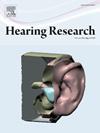No association between idiopathic hidden hearing loss and behavioral adaptation to noise in humans
IF 2.5
2区 医学
Q1 AUDIOLOGY & SPEECH-LANGUAGE PATHOLOGY
引用次数: 0
Abstract
Adaptation to noise refers to the improvement in word-in-noise recognition as words are delayed a few hundred milliseconds in the noise. This adaptation is thought to reflect adjustments of the dynamic range of auditory neurons to the most frequent noise level. Evidence from a mouse model suggests that hidden hearing loss (HHL), a diminished auditory nerve response without a hearing loss, selectively impairs neural dynamic range adaptation to loud sound environments. The aim of the present study was to investigate whether HHL is associated with poor behavioral adaptation to loud noise in speech recognition.
For 89 people (aged 19–86 years) with clinically normal hearing, we measured speech reception thresholds (SRTs; signal-to-noise ratios at 50 % recognition) for disyllabic words in stationary, speech-shaped noise. SRTs were measured for words delayed 50 and 800 ms in the noise and for noise levels of 55 and 78 dB SPL. Adaptation was calculated as the SRT improvement in the long-delay relative to the short-delay condition. Because adaptation is greater for vocoded than for natural words, words were processed through a tone vocoder. The response of the auditory nerve was assessed using the amplitude of the auditory brainstem response (ABR) wave I and the rate of growth (slope) of the wave I amplitude with increasing stimulus level.
Adaptation occurred at the two noise levels but was greater for the louder noise than for the softer noise (2.3 dB vs 1.3 dB, respectively). This happened because SRTs were worse for the louder noise in the short but not in the long delay condition. The large variability in ABR wave I amplitude (0.10 to 0.54 μV) and slope (-0.004 to 0.023 μV/dB) suggested that the sample included participants with varying degrees of HHL of uncertain etiology (idiopathic). However, adaptation was not correlated with the wave I amplitude or slope, even after accounting for the potential confounding effect of elevated hearing thresholds in an extended frequency range.
Findings suggest that adaptation to noise in speech recognition is greater at higher noise levels but provide no evidence that idiopathic HHL leads to reduced adaptation to noise in humans.
人类特发性隐蔽性听力损失与噪音行为适应之间无关联
对噪声的适应是指在噪声中单词识别能力的提高,因为单词在噪声中被延迟了几百毫秒。这种适应被认为反映了听觉神经元对最频繁的噪音水平的动态范围的调整。来自小鼠模型的证据表明,隐性听力损失(HHL)是一种听觉神经反应减弱而没有听力损失的情况下,选择性地损害了神经动态范围对大声声音环境的适应。本研究的目的是调查HHL是否与语音识别中对大声噪音的不良行为适应有关。对于89名临床听力正常的患者(年龄19-86岁),我们测量了语音接收阈值(SRTs;信噪比在50%识别)的双音节词在固定的,语音形状的噪音。在噪声延迟50和800 ms以及噪声水平为55和78 dB SPL时测量srt。自适应计算为长延迟条件下相对于短延迟条件下的SRT改进。由于语音编码的适应性比自然单词更强,所以单词是通过音调声码器处理的。用听觉脑干反应(ABR)波I的振幅和波I振幅随刺激水平增加的增长率(斜率)来评估听神经的反应。适应发生在两种噪音水平上,但更大声的噪音比更柔和的噪音(分别为2.3 dB和1.3 dB)更大。这是因为在短延迟条件下,srt对更大的噪音更糟糕,而在长延迟条件下则不然。ABR波I振幅(0.10 ~ 0.54 μV)和斜率(-0.004 ~ 0.023 μV/dB)的大变异性表明,样本中包括不同程度的HHL,病因不明(特发性)。然而,适应性与波I振幅或斜率无关,即使考虑到在扩大的频率范围内听力阈值升高的潜在混淆效应。研究结果表明,在较高的噪声水平下,语音识别中对噪声的适应能力更强,但没有证据表明特发性HHL导致人类对噪声的适应能力降低。
本文章由计算机程序翻译,如有差异,请以英文原文为准。
求助全文
约1分钟内获得全文
求助全文
来源期刊

Hearing Research
医学-耳鼻喉科学
CiteScore
5.30
自引率
14.30%
发文量
163
审稿时长
75 days
期刊介绍:
The aim of the journal is to provide a forum for papers concerned with basic peripheral and central auditory mechanisms. Emphasis is on experimental and clinical studies, but theoretical and methodological papers will also be considered. The journal publishes original research papers, review and mini- review articles, rapid communications, method/protocol and perspective articles.
Papers submitted should deal with auditory anatomy, physiology, psychophysics, imaging, modeling and behavioural studies in animals and humans, as well as hearing aids and cochlear implants. Papers dealing with the vestibular system are also considered for publication. Papers on comparative aspects of hearing and on effects of drugs and environmental contaminants on hearing function will also be considered. Clinical papers will be accepted when they contribute to the understanding of normal and pathological hearing functions.
 求助内容:
求助内容: 应助结果提醒方式:
应助结果提醒方式:


